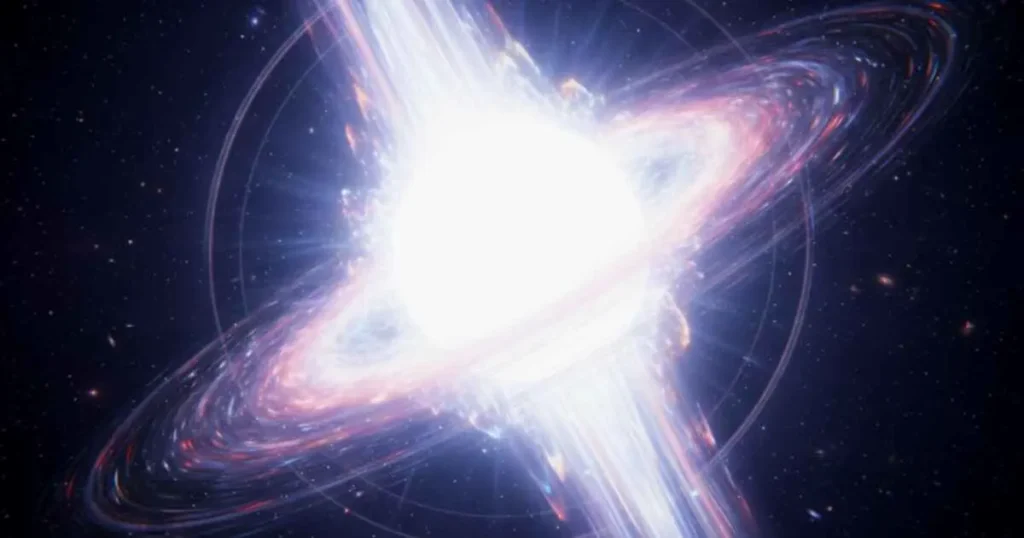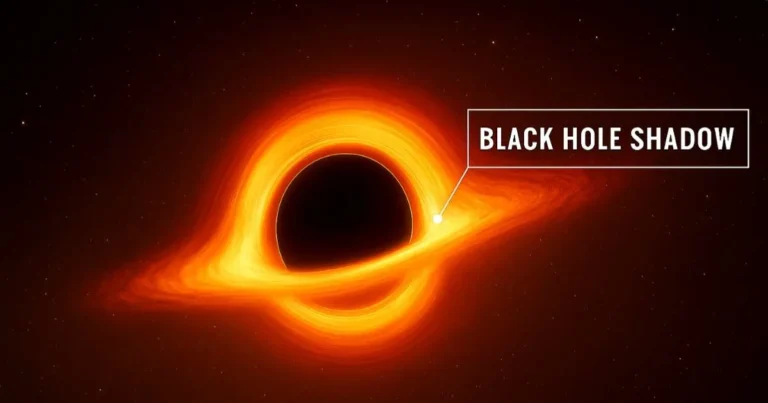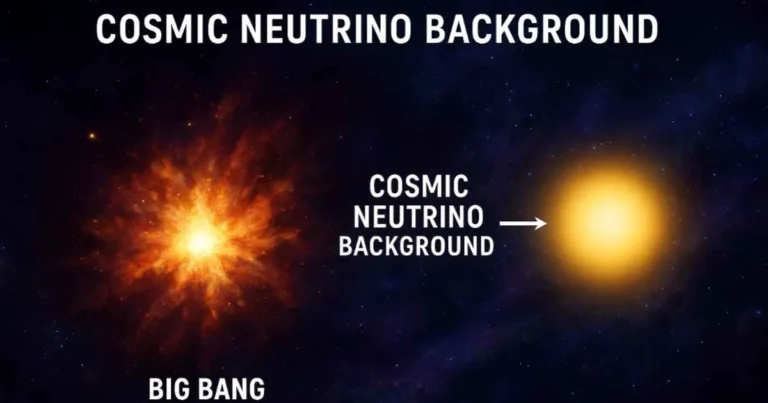White Holes: The Universe’s Reverse Gear

Tags:
- white holes
If we were to rank the theories that have changed human history forever, the General Theory of Relativity would be at the top. The results it reveals are beyond human understanding. They show that the cosmos is filled with perplexing phenomena, some of which are purely hypothetical yet mathematically elegant. One such phenomenon is the white hole. White holes are regarded as the time-reverse of black holes. Black holes are known for engulfing everything that comes into it while the white holes are known for spewing out matter and energy. Black holes and White Holes are simply polar opposite to each other. However, Black Holes have been discovered and photographed while White holes still exist in theories because exploring white holes requires us to delve into the deepest parts of General Relativity, challenging our understanding of spacetime. Let’s check it out everything that you need to know about White Holes.
Defining the Cosmic Fountain
What Exactly is a White Hole?
A white hole is a mysterious region of spacetime where the rules of the universe seem to bend. Nothing can enter it from the outside, yet matter and light are believed to burst out of it, almost as if defying the laws of thermodynamics. On paper, it’s a mathematically valid, though deeply puzzling solution to Einstein’s field equations. Think of it as a cosmic fountain, endlessly spewing energy and light into the universe.
Event Horizon in Reverse
Like black holes, a white hole also possesses an event horizon, but its function is inverted. Let’s understand the meaning of Event Horizon for black holes first, and then we’ll look for the white holes. For a black hole, the event horizon is the “point of no return,” i.e., beyond this point, nothing, not even light, can escape. This is because of its extremely strong gravitational pull. But for a white hole, the event horizon is the point of no entry which means that nothing can enter into it. From this point light(Photons) and matter can only travel away from this boundary, never towards it. This inverse nature arises directly from the time-reversal symmetry applied to the black hole solution in mathematics.
A Brief History of Theoretical Oddities
The Einstein-Rosen Bridge
Back in 1916, a German physicist, Karl Schwarzschild, published one of the first modern solutions to Einstein’s field equations, which resulted in the discovery of black holes. Later, the existence of black holes was proven and became widely known. He called his solution the Schwarzschild metric in his honor. The solution also led to the concept of the white hole, which appeared as a component of the solution he had given.
His solutions are also regarded as the simplest and earliest solutions to Einstein’s field equations. When mathematically extended, these solutions suggested a connection between two separate regions of spacetime, featuring both a black hole and a white hole. This connection was later dubbed the Einstein-Rosen Bridge, or a basic type of wormhole. Einstein-Rosen bridges or wormholes are generally considered shortcuts through the universe. It is believed that, in theory, we could travel light-years away in the blink of an eye if we ever entered a wormhole. However, we haven’t discovered any such phenomenal objects yet. Early theorists realized that the “eternal black hole” solution mathematically included a region from which matter exits.
Penrose and The Singularities
Later work by physicists, including Roger Penrose, refined the understanding of spacetime singularities. Black holes also have singularities, but the question is: What is a singularity?
A singularity is a point in space where the entire mass of a black hole is concentrated, making it a region of infinite density that causes space and time to break down. Similar to its counterpart, a white hole also contains a central singularity. In black holes, matter and light are crushed toward this point, but in the case of white holes, light and matter must be seen as perpetually emerging from it. In this theoretical model, the flow of time is reversed for a black hole, resulting in an object that explodes instead of imploding. This purely mathematical consistency grants the white hole its theoretical validity, even in the absence of physical evidence. This leads to profound theoretical challenges regarding where that matter originates. However, its physical origin is doubted by physicists all around the world because it defies the laws of thermodynamics.
Stability and Thermodynamics
As I mentioned above, the primary reason physicists doubt the physical reality of white holes is their extreme instability. Physicists believe that even the smallest disturbance would cause a white hole to collapse into a black hole. More critically, the existence of white holes appears to violate the Second Law of Thermodynamics. According to this law, “entropy (disorder) must always increase.”
A white hole is supposed to be emitting light and matter from its singularity, which means its entropy is decreasing, not increasing. This simply makes it impossible for a white hole to exist in the universe because the laws of thermodynamics are among the most reliable ever theorized, and they form a fundamental part of the nature of the universe.
Are They Real? Observational Evidence
The Absence of Observation
We have telescopes that can observe objects that are light-years away from us. Using these telescopes, we now know how a black hole may look, which is kind of a sibling to white holes. To date, “no white hole has ever been directly observed” or confirmed to exist in the cosmos. Perhaps both of them are solutions of the same equation, but one has been observed and the latter is yet to be observed. However, if one did exist, it would manifest as an unimaginably powerful, continuous burst of energy and matter, distinguishable from transient events like supernova explosions.
However, it still challenges us whether we have not yet invented the kind of instrument that can detect it, or whether they cannot exist. But we are well acquainted with a kind of singularity that created our Universe 13.8 billion years ago: the Big Bang singularity, which actually exploded matter and brought our Universe into existence. Is there any relationship between white holes and the Big Bang?
White Holes and The Big Bang
White holes are objects that explode matter and energy and have a singularity. 13.8 billion years ago, there was an infinitely dense singularity that exploded, and matter and light came out of it and formed the Universe where we all live. Both definitions look kind of the same, as if the Big Bang is nothing but a white hole event spewing out matter and light from itself, because the Big Bang completely aligns with the conceptual definition of white holes. However, this is purely speculative, as this idea offers an intriguing way to link one of the universe’s greatest mysteries to one of physics’ greatest theoretical constructs.
Conclusion: Expanding the Cosmic Toolkit
The Lasting Impact of a Thought Experiment
White holes are not just cosmic novelties; they are essential theoretical “extremes” because if we were somehow able to discover one, it could answer so many questions. It could even give us an idea of interstellar travel and the formation of our Universe. They force physicists to stress-test the limits of General Relativity and explore crucial concepts in quantum gravity. By analyzing why white holes are physically forbidden or unstable, we gain deeper insights into the necessary conditions for black hole formation and the fundamental nature of spacetime.
They act as a theoretical mirror for understanding gravity’s most complex boundaries. But, as they say, we just can’t focus only on the positive picture, because these white holes are also ones that don’t obey the laws of thermodynamics. And if we were to discover one, we would have to re-evaluate a theory that answers so many of our questions in a way that actually makes sense.
For a broader reflection on how human perception shapes our understanding of the cosmos, you can explore The Cognitive Limits of Human Astronomy a related discussion on how our minds frame and sometimes constrain what we can comprehend about the Universe.
Benefit to Humanity: The Power of Fundamental Physics
Though the study of objects like white holes benefits humanity by driving advancements in fundamental science, the deep mathematical work on General Relativity created by such concepts forms the same theoretical roots that are behind technologies like GPS systems (which rely on highly accurate relativistic calculations). Furthermore, a complete understanding of black holes, white holes, and singularities is a prerequisite for developing a Unified Theory of Everything (Quantum Gravity). Achieving this theory would revolutionize our understanding of the universe, potentially unlocking new energy principles and technological breakthroughs far beyond our current imagination.
Comments
Please log in to leave a comment.
Related Posts

Magnetar: The Universe’s Most Extreme Magnetic Monster
Magnetars are ultra-magnetic neutron stars, cosmic beasts that emit bursts of radiation so powerful they can shake entire galaxies. Learn how they form, what makes them unique, and why their mystery continues to fascinate astronomers.

What Is a Black Hole Shadow? The Ultimate Glimpse into the Abyss
If you could stare into the heart of a galaxy, past the light, past the stars, and into pure darkness, what would you actually see? When astronomers talk about the black hole shadow, they’re referring to one of the most mind-bending sights in the universe, the silhouette of the unseeable, the faint outline of where […]

Cosmic Neutrino Background: The Ghostly Relic of the Big Bang
The Cosmic Neutrino Background is the ghostly radiation from the Big Bang’s first second. Undetected yet essential, it holds secrets about neutrino mass, dark matter, and the universe’s origin story. Here’s why scientists are chasing this invisible relic.